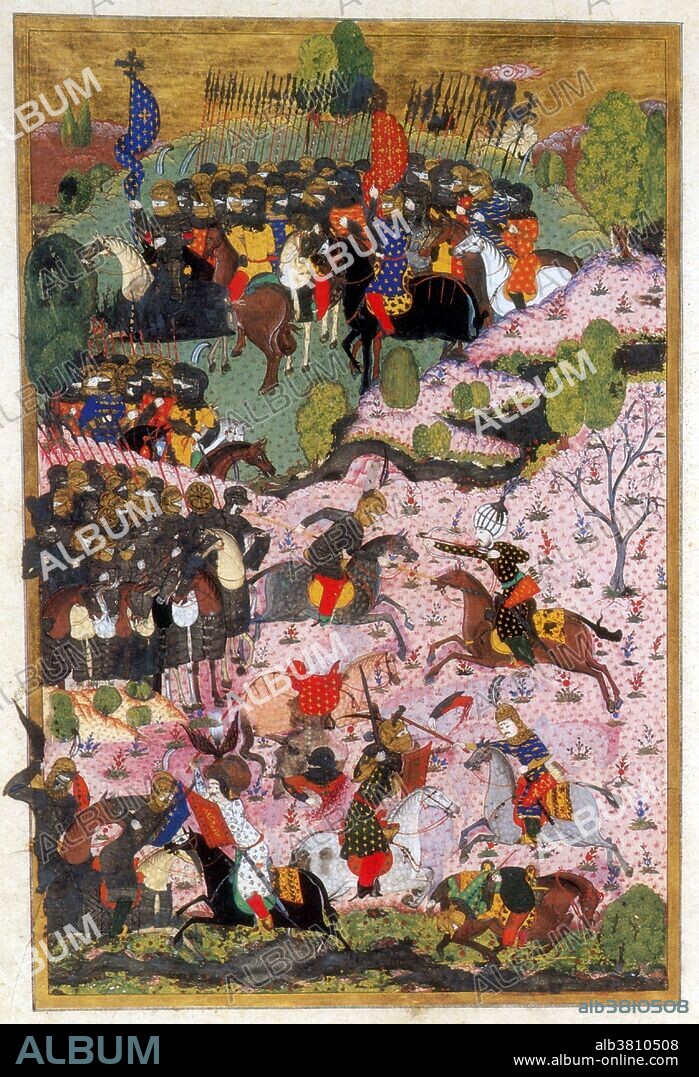alb3810508
Ottoman-Hungarian Wars, Battle of Mohà ¡cs, 1526

|
Añadir a otro lightbox |
|
Añadir a otro lightbox |



¿Ya tienes cuenta? Iniciar sesión
¿No tienes cuenta? Regístrate
Compra esta imagen.
Selecciona el uso:

Título:
Ottoman-Hungarian Wars, Battle of Mohà ¡cs, 1526
Descripción:
Traducción automática: La Batalla de Mohács fue una de las batallas de mayor trascendencia en la historia de Europa Central. Se libró el 29 de agosto de 1526 cerca de Mohács, Reino de Hungría, entre las fuerzas del Reino de Hungría, dirigidas por Luis II, y las del Imperio Otomano, dirigidas por Solimán el Magnífico. Hungría tenía un ejército costoso pero obsoleto, que dependía de caballeros fuertemente armados sobre caballos blindados. El frente de batalla húngaro constaba de dos líneas, la primera con un centro de infantería y artillería mercenarias y la mayoría de la caballería en cada flanco. La segunda línea era una mezcla de infantería de leva y caballería. El ejército otomano era una fuerza más moderna construida alrededor de la élite, los jenízaros armados con mosquetes y la artillería. Los húngaros sufrieron graves bajas a causa de la artillería turca y las andanadas de mosquetes hábilmente manejadas. Los húngaros no pudieron mantener sus posiciones y los que no huyeron fueron rodeados y asesinados o capturados. La victoria otomana condujo a la partición de Hungría durante varios siglos entre el Imperio Otomano, la Monarquía de los Habsburgo y el Principado de Transilvania. Además, la muerte de Luis II cuando huía de la batalla marcó el final de la dinastía Jagiellon en Hungría y Bohemia, cuyos reclamos dinásticos pasaron a la Casa de los Habsburgo.
The Battle of Mohács was one of the most consequential battles in Central European history. It was fought on August 29, 1526 near Mohács, Kingdom of Hungary, between the forces of the Kingdom of Hungary, led by Louis II, and those of the Ottoman Empire, led by Suleiman the Magnificent. Hungary had an expensive but obsolete army, reliant on heavily armored knights on armored horses. The Hungarian battlefront consisted of two lines, the first with a center of mercenary infantry and artillery and the majority of the cavalry on either flank. The second line was a mix of levy infantry and cavalry. The Ottoman army was a more modern force built around the elite, musket-armed Janissaries, and artillery. The Hungarians took serious casualties from the skillfully handled Turkish artillery and musket volleys. The Hungarians could not hold their positions, and those who did not flee were surrounded and killed or captured. The Ottoman victory led to the partition of Hungary for several centuries between the Ottoman Empire, the Habsburg Monarchy, and the Principality of Transylvania. Further, the death of Louis II as he fled the battle marked the end of the Jagiellon dynasty in Hungary and Bohemia, whose dynastic claims passed to the House of Habsburg.
Crédito:
Album / NYPL/Science Source
Autorizaciones:
Modelo: No - Propiedad: No
¿Preguntas relacionadas con los derechos?
¿Preguntas relacionadas con los derechos?
Tamaño imagen:
3073 x 4500 px | 39.6 MB
Tamaño impresión:
26.0 x 38.1 cm | 10.2 x 15.0 in (300 dpi)
Palabras clave:
ACONTECIMIENTO • ARTE • BATALLA • CABALLERIA • CABALLERO • CAMPO DE BATALLA • COMBATE • CONFLICTO BELICO • EUROPEA • EUROPEAS • EUROPEO • FAMOSA • FAMOSO • GENTLEMAN • GUERRA • HISTORIA • HISTORICO • IMPERIO OTOMANO • IMPERIO TURCO • IMPORTANTE • INFANTERIA • ISLAM • ISLÁMICO • JINETE • LUCHA • LUCHANDO • MANUSCRITO ILUMINADO • MANUSCRITO MINIADO • MILITAR • MINIATURA • MUSULMAN • OBRA DE ARTE • PINTURA • S. XVI • SIGLO XVI • SULTAN • TURCO • WAR
 Pinterest
Pinterest Twitter
Twitter Facebook
Facebook Copiar enlace
Copiar enlace Email
Email
